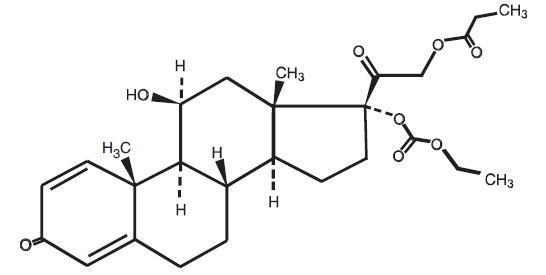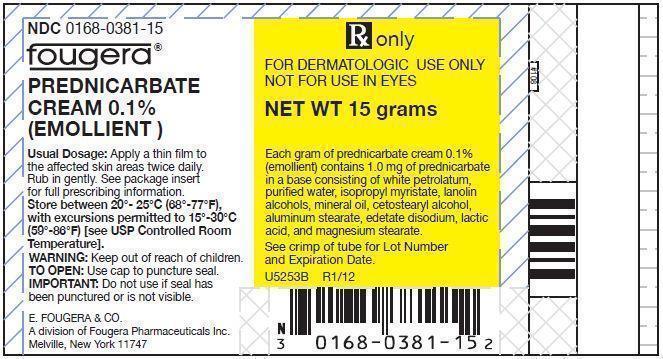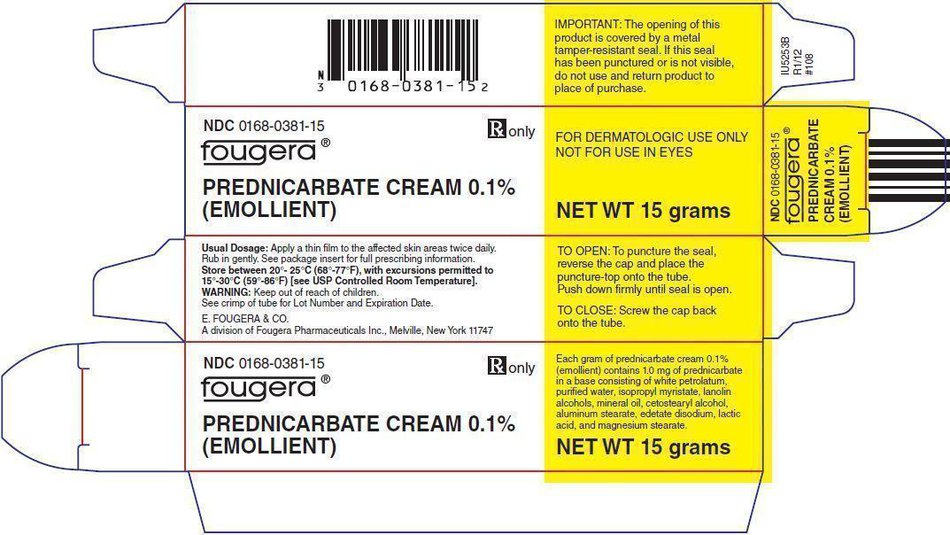Prednicarbate by E. Fougera & Co. a division of Fougera Pharmaceuticals Inc. PREDNICARBATE cream
Prednicarbate by
Drug Labeling and Warnings
Prednicarbate by is a Prescription medication manufactured, distributed, or labeled by E. Fougera & Co. a division of Fougera Pharmaceuticals Inc.. Drug facts, warnings, and ingredients follow.
Drug Details [pdf]
- SPL UNCLASSIFIED SECTION
-
DESCRIPTION:
Prednicarbate cream 0.1% (emollient) contains prednicarbate, a synthetic corticosteroid for topical dermatologic use. The chemical name of prednicarbate is 11β, 17,21-trihydroxypregna-1,4-diene- 3,20-dione 17-(ethyl carbonate) 21-propionate. Prednicarbate has the empirical formula C27H36O8 and a molecular weight of 488.58. Topical corticosteroids constitute a class of primarily synthetic steroids used topically as anti-inflammatory and antipruritic agents. The CAS Registry Number is 73771-04-7.
The chemical structure is:
Prednicarbate is a practically odorless white to yellow-white powder insoluble to practically insoluble in water and freely soluble in ethanol.
Each gram of prednicarbate cream 0.1% (emollient) contains 1.0 mg of prednicarbate in a base consisting of white petrolatum, purified water, isopropyl myristate, lanolin alcohols, mineral oil, cetostearyl alcohol, aluminum stearate, edetate disodium, lactic acid, and magnesium stearate.
-
CLINICAL PHARMACOLOGY:
In common with other topical corticosteroids, prednicarbate has anti-inflammatory, antipruritic, and vasoconstrictive properties. In general, the mechanism of the anti-inflammatory activity of topical steroids is unclear. However, corticosteroids are thought to act by the induction of phospholipase A2 inhibitory proteins, collectively called lipocortins. It is postulated that these proteins control the biosynthesis of potent mediators of inflammation such as prostaglandins and leukotrienes by inhibiting the release of their common precursor arachidonic acid. Arachidonic acid is released from membrane phospholipids by phospholipase A2.
Pharmacokinetics: The extent of percutaneous absorption of topical corticosteroids is determined by many factors, including the vehicle and the integrity of the epidermal barrier. Use of occlusive dressings with hydrocortisone for up to 24 hours have not been shown to increase penetration; however, occlusion of hydrocortisone for 96 hours does markedly enhance penetration. Topical corticosteroids can be absorbed from normal intact skin. Inflammation and/or other disease processes in the skin increase percutaneous absorption. Studies performed with prednicarbate cream 0.1% (emollient) indicate that the drug product is in the medium range of potency compared with other topical corticosteroids.
-
INDICATIONS AND USAGE:
Prednicarbate cream 0.1% (emollient) is a medium-potency corticosteroid indicated for the relief of the inflammatory and pruritic manifestations of corticosteroid responsive dermatoses. Prednicarbate cream 0.1% (emollient) may be used with caution in pediatric patients 1 year of age or older. The safety and efficacy of drug use for longer than 3 weeks in this population have not been established. Since safety and efficacy of prednicarbate cream 0.1% (emollient) have not been established in pediatric patients below 1 year of age, its use in this age group is not recommended.
- CONTRAINDICATIONS:
-
PRECAUTIONS:
General: Systemic absorption of topical corticosteroids can produce reversible hypothalamic-pituitary-adrenal (HPA) axis suppression with the potential for glucocorticosteroid insufficiency after withdrawal of treatment. Manifestations of Cushing's syndrome, hyperglycemia, and glucosuria can also be produced in some patients by systemic absorption of topical corticosteroids while on treatment. Patients applying a topical steroid to a large surface area or under occlusion should be evaluated periodically for evidence of HPA-axis suppression. This may be done by using the ACTH stimulation, A.M. plasma cortisol, and urinary free cortisol tests. Prednicarbate cream 0.1% (emollient) did not produce significant HPA-axis suppression when used at a dose of 30g/day for a week in 10 adult patients with extensive psoriasis or atopic dermatitis. Prednicarbate cream 0.1% (emollient) did not produce HPA-axis suppression in any of 59 pediatric patients with extensive atopic dermatitis when applied BID for 3 weeks to > 20% of the body surface. (See PRECAUTIONS, Pediatric Use). If HPA-axis suppression is noted, an attempt should be made to withdraw the drug, to reduce the frequency of the application, or to substitute a less potent corticosteroid. Recovery of HPA-axis function is generally prompt upon discontinuation of topical corticosteroids. Infrequently, signs and symptoms of glucocorticosteroid insufficiency may occur, requiring supplemental systemic corticosteroids. For information on systemic supplementation, see prescribing information for those products. Pediatric patients may be more susceptible to systemic toxicity from equivalent doses due to their larger skin surface to body mass ratios. (See PRECAUTIONS, Pediatric Use).
If irritation develops, prednicarbate cream 0.1% (emollient) should be discontinued and appropriate therapy instituted. Allergic contact dermatitis with corticosteroids is usually diagnosed by observing a failure to heal rather than noting a clinical exacerbation, as observed with most topical products not containing corticosteroids. Such an observation should be corroborated with appropriate diagnostic patch testing. If concomitant skin infections are present or develop, an appropriate antifungal or antibacterial agent should be used. If a favorable response does not occur promptly, use of prednicarbate cream 0.1% (emollient) should be discontinued until the infection has been adequately controlled.
Information for Patients
Patients using topical corticosteroids should receive the following information and instructions:
- 1. This medication is to be used as directed by the physician. It is for external use only. Avoid contact with the eyes.
- 2. This medication should not be used for any disorder other than that for which it was prescribed.
- 3. The treated skin area should not be bandaged, otherwise covered or wrapped so as to be occlusive, unless directed by the physician.
- 4. Patients should report to their physician any signs of local adverse reactions.
- 5. Parents of pediatric patients should be advised not to use this medication in the treatment of diaper dermatitis. This medication should not be applied in the diaper area as diapers or plastic pants may constitute occlusive dressing (See DOSAGE AND ADMINISTRATION).
- 6. This medication should not be used on the face, underarms, or groin areas.
- 7. Contact between Prednicarbate Cream 0.1% (emollient) and latex containing products (eg. condoms, diaphragm etc.) should be avoided since paraffin in contact with latex can cause damage and reduce the effectiveness of any latex containing products. If latex products come into contact with Prednicarbate Cream 0.1% (emollient), patients should be advised to discard the latex products. Patients should be advised that this medication is to be used externally only, not intravaginally.
As with other corticosteroids, therapy should be discontinued when control is achieved. If no improvement is seen within two weeks, contact the physician.
Laboratory Tests: The following tests may be helpful in evaluating patients for HPA-axis suppression: ACTH stimulation test, AM plasma cortisol test, Urinary free cortisol test.
Carcinogenesis, Mutagenesis, and Impairment of Fertility: In a study of the effect of prednicarbate on fertility, pregnancy, and postnatal development in rats, no effect was noted on the fertility or pregnancy of the parent animals or postnatal development of the offspring after administration of up to 0.80 mg/kg of prednicarbate subcutaneously. Prednicarbate has been evaluated in the Salmonella reversion test (Ames test) over a wide range of concentrations in the presence and absence of an S-9 liver microsomal fraction, and did not demonstrate mutagenic activity. Similarly, prednicarbate did not produce any significant changes in the numbers of micronuclei seen in erythrocytes when mice were given doses ranging from 1 to 160 mg/kg of the drug.
Pregnancy:
Teratogenic Effects
Pregnancy Category C
Corticosteroids have been shown to be teratogenic in laboratory animals when administered systemically at relatively low dosage levels. Some corticosteroids have been shown to be teratogenic after dermal application in laboratory animals. Prednicarbate has been shown to be teratogenic and embryotoxic in Wistar rats and Himalayan rabbits when given subcutaneously during gestation at doses 1900 times and 45 times the recommended topical human dose, assuming a percutaneous absorption of approximately 3%. In the rats, slightly retarded fetal development and an incidence of thickened and wavy ribs higher than the spontaneous rate were noted. In rabbits, increased liver weights and slight increase in the fetal intrauterine death rate were observed. The fetuses that were delivered exhibited reduced placental weight, increased frequency of cleft palate, ossification disorders in the sternum, omphalocele, and anomalous posture of the forelimbs. There are no adequate and well-controlled studies in pregnant women on teratogenic effects of prednicarbate. Prednicarbate cream 0.1% (emollient) should be used during pregnancy only if the potential benefit justifies the potential risk to the fetus.
Nursing Mothers: Systemically administered corticosteroids appear in human milk and could suppress growth, interfere with endogenous corticosteroid production, or cause other untoward effects. It is not known whether topical administration of corticosteroids could result in sufficient systemic absorption to produce detectable quantities in human milk. Because many drugs are excreted in human milk, caution should be exercised when prednicarbate cream 0.1% (emollient) is administered to a nursing woman.
Pediatric Use: Prednicarbate cream 0.1% (emollient) may be used with caution in pediatric patients 1 year of age or older, although the safety and efficacy of drug use longer than 3 weeks have not been established. The use of prednicarbate cream 0.1% (emollient) is supported by results of a three week, uncontrolled study in 59 pediatric patients between the ages of 4 months and 12 years of age with atopic dermatitis. None of the 59 pediatric patients showed evidence of HPA-axis suppression. Safety and efficacy of prednicarbate cream 0.1% (emollient) in pediatric patients below 1 year of age have not been established, therefore use in this age group is not recommended. Because of a higher ratio of skin surface area to body mass, pediatric patients are at a greater risk than adults of HPA-axis suppression and Cushing's syndrome when they are treated with topical corticosteroids. They are therefore also at greater risk of adrenal insufficiency during and/or after withdrawal of treatment. In an uncontrolled study in pediatric patients with atopic dermatitis, the incidence of adverse reactions possibly or probably associated with the use of prednicarbate cream 0.1% (emollient) was limited. Mild signs of atrophy developed in 5 patients (5/59, 8%) during the clinical trial, with 2 patients exhibiting more than one sign. Two patients (2/59, 3%) developed shininess, and two patients (2/59, 3%) developed thinness. Three patients (3/59, 5%) were observed with mild telangiectasia. It is unknown whether prior use of topical corticosteroids was a contributing factor in the development of telangiectasia in 2 of the patients. Adverse effects including striae have also been reported with inappropriate use of topical corticosteroids in infants and children. Pediatric patients applying topical corticosteroids to greater than 20% of body surface are at higher risk for HPA-axis suppression. HPA axis suppression, Cushing's syndrome, linear growth retardation, delayed weight gain and intracranial hypertension have been reported in children receiving topical corticosteroids. Manifestations of adrenal suppression in children include low plasma cortisol levels, and absence of response to ACTH stimulation. Manifestations of intracranial hypertension include bulging fontanelles, headaches, and bilateral papilledema. Prednicarbate cream 0.1% (emollient) should not be used in the treatment of diaper dermatitis.
-
ADVERSE REACTIONS:
In controlled adult clinical studies, the incidence of adverse reactions probably or possibly associated with the use of prednicarbate cream 0.1% (emollient) was approximately 4%. Reported reactions included mild signs of skin atrophy in 1% of treated patients, as well as the following reactions which were reported in less than 1% of patients: pruritis, edema, paresthesia, urticaria, burning, allergic contact dermatitis and rash. In an uncontrolled study in pediatric patients with atopic dermatitis, the incidence of adverse reactions possibly or probably associated with the use of prednicarbate cream 0.1% (emollient) was limited. Mild signs of atrophy developed in 5 patients (5/59, 8%) during the clinical trial, with 2 patients exhibiting more than one sign. Two patients (2/59, 3%) developed shininess, and 2 patients (2/59, 3%) developed thinness. Three patients (3/59, 5 %) were observed with mild telangiectasia. It is unknown whether prior use of topical corticosteroids was a contributing factor in the development of telangiectasia in 2 of the patients (See PRECAUTIONS, Pediatric Use). The following additional local adverse reactions have been reported infrequently with topical corticosteroids, but may occur more frequently with the use of occlusive dressings. These reactions are listed in an approximate decreasing order of occurrence: folliculitis, acneiform eruptions, hypopigmentation, perioral dermatitis, secondary infection, striae and miliaria.
-
OVERDOSAGE:
Topically applied corticosteroids can be absorbed in sufficient amounts to produce systemic effects. (See PRECAUTIONS).
-
DOSAGE AND ADMINISTRATION:
Apply a thin film of prednicarbate cream 0.1% (emollient) to the affected skin areas twice daily. Rub in gently. Prednicarbate cream 0.1% (emollient) may be used in pediatric patients 1 year of age or older. Safety and efficacy of prednicarbate cream 0.1% (emollient) in pediatric patients for more than 3 weeks of use have not been established. Use in pediatric patients under 1 year of age is not recommended. As with other corticosteroids, therapy should be discontinued when control is achieved. If no improvement is seen within 2 weeks, reassessment of the diagnosis may be necessary. Prednicarbate cream 0.1% (emollient) should not be used with occlusive dressings unless directed by the physician. Prednicarbate cream 0.1% (emollient) should not be applied in the diaper area if the child still requires diapers or plastic pants as these garments may constitute occlusive dressing.
-
HOW SUPPLIED:
Prednicarbate Cream, 0.1% (Emollient) is supplied:
15 gram tube NDC: 0168-0381-15
60 gram tube NDC: 0168-0381-60Store between 20°-25° C (68°-77° F), with excursions permitted to 15°-30° C (59°–86°F). [see USP Controlled Room Temperature].
E. Fougera & Co.
A division of
Fougera
PHARMACEUTICALS INC.
Melville, New York 11747I2381D
R10/15
#108 - PACKAGE LABEL – PRINCIPAL DISPLAY PANEL – 15 G CONTAINER
- PACKAGE LABEL – PRINCIPAL DISPLAY PANEL – 15 G CARTON
-
INGREDIENTS AND APPEARANCE
PREDNICARBATE
prednicarbate creamProduct Information Product Type HUMAN PRESCRIPTION DRUG Item Code (Source) NDC: 0168-0381 Route of Administration TOPICAL Active Ingredient/Active Moiety Ingredient Name Basis of Strength Strength PREDNICARBATE (UNII: V901LV1K7D) (PREDNICARBATE - UNII:V901LV1K7D) PREDNICARBATE 1 mg in 1 g Inactive Ingredients Ingredient Name Strength PETROLATUM (UNII: 4T6H12BN9U) ISOPROPYL MYRISTATE (UNII: 0RE8K4LNJS) LANOLIN ALCOHOLS (UNII: 884C3FA9HE) CETOSTEARYL ALCOHOL (UNII: 2DMT128M1S) ALUMINUM STEARATE (UNII: U6XF9NP8HM) WATER (UNII: 059QF0KO0R) EDETATE DISODIUM (UNII: 7FLD91C86K) MINERAL OIL (UNII: T5L8T28FGP) LACTIC ACID (UNII: 33X04XA5AT) MAGNESIUM STEARATE (UNII: 70097M6I30) Packaging # Item Code Package Description Marketing Start Date Marketing End Date 1 NDC: 0168-0381-15 15 g in 1 TUBE; Type 0: Not a Combination Product 2 NDC: 0168-0381-60 60 g in 1 TUBE; Type 0: Not a Combination Product Marketing Information Marketing Category Application Number or Monograph Citation Marketing Start Date Marketing End Date ANDA ANDA077287 09/19/2006 Labeler - E. Fougera & Co. a division of Fougera Pharmaceuticals Inc. (043838424)
© 2025 FDA.report
This site is not affiliated with or endorsed by the FDA.


